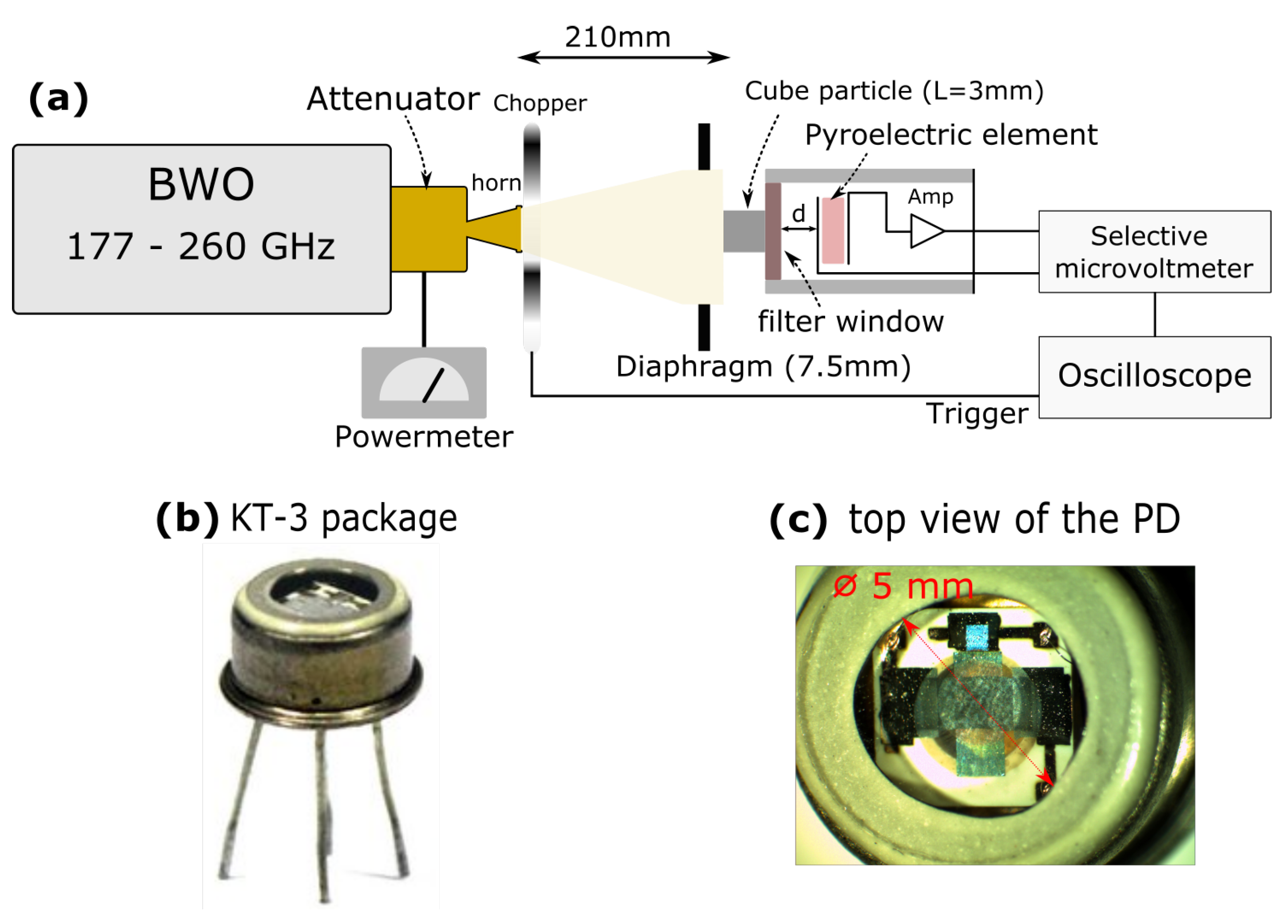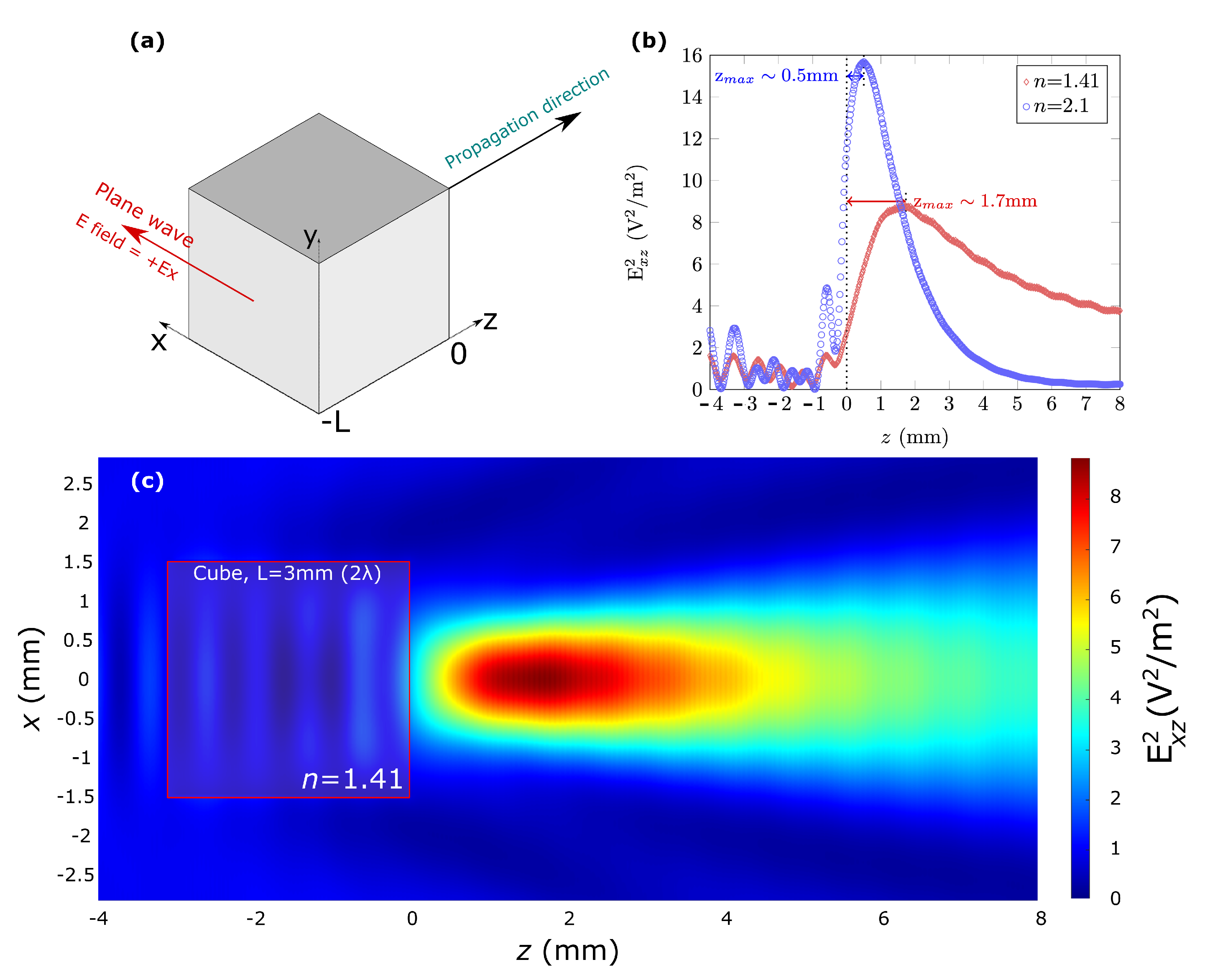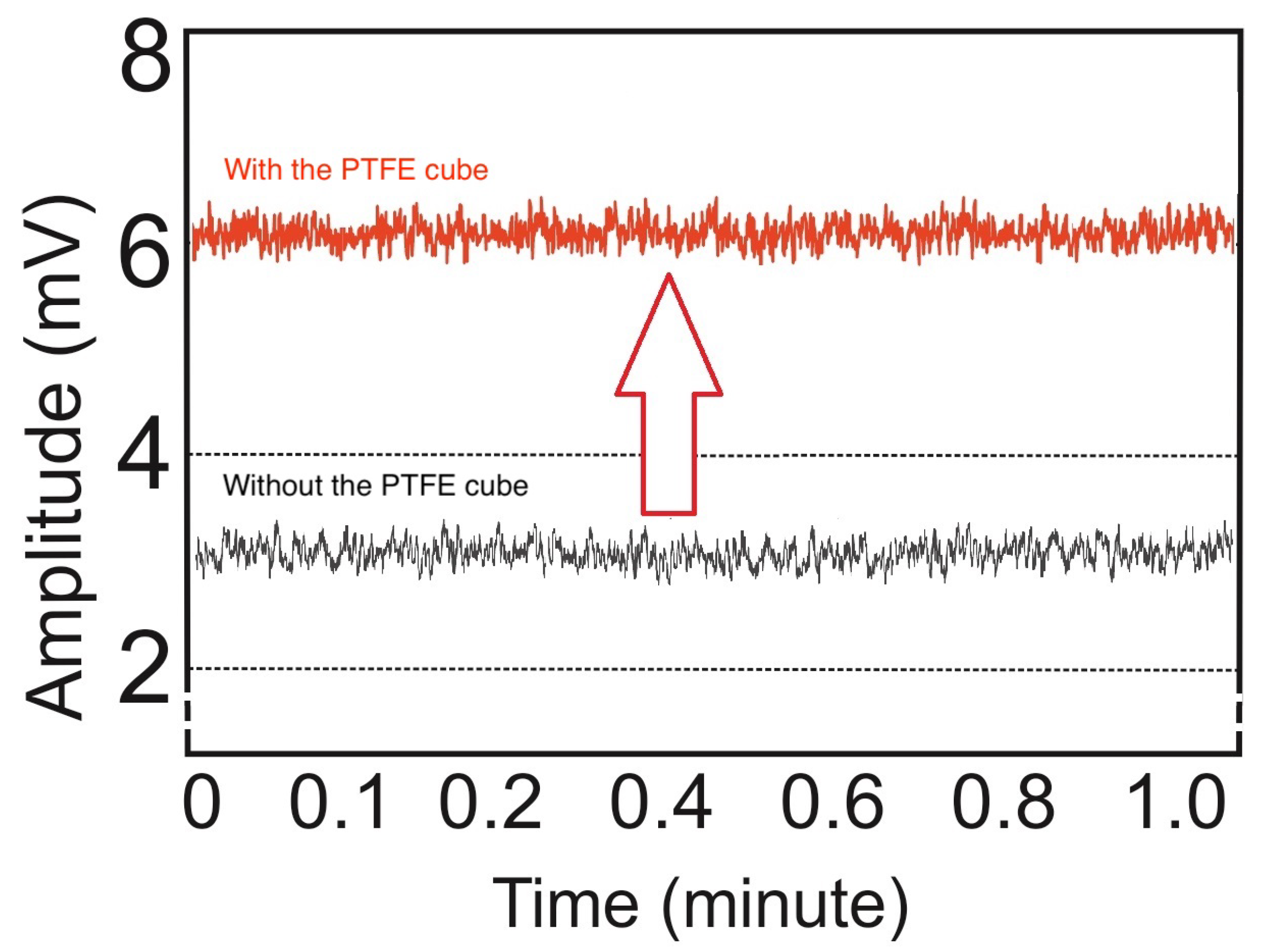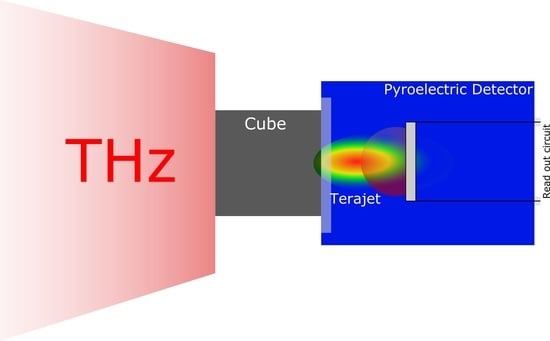Improvement of an InfraRed Pyroelectric Detector Performances in THz Range Using the Terajet Effect
Abstract
:1. Introduction
2. Experimental Setup and Methods
3. Results and Discussions
4. Conclusions
Author Contributions
Funding
Institutional Review Board Statement
Informed Consent Statement
Data Availability Statement
Conflicts of Interest
Abbreviations
| BWO | Backward Wave Oscillator |
| IR | Infrared |
| NEP | Noise Equivalent Power |
| PD | Pyroelectric Detector |
| PTFE | Polytetrafluoroethylene |
| SNR | Signal-to-noise ratio |
| TDS | Time-domain spectroscopy |
| THz | Terahertz |
References
- Dhillon, S.S.; Vitiello, M.S.; Linfield, E.H.; Davies, A.G.; Hoffmann, M.C.; Booske, J.; Paoloni, C.; Gensch, M.; Weightman, P.; Williams, G.P.; et al. The 2017 terahertz science and technology roadmap. J. Phys. D Appl. Phys. 2017, 50, 043001. [Google Scholar] [CrossRef]
- Kawase, K.; Ogawa, Y.; Watanabe, Y.; Inoue, H. Non-destructive terahertz imaging of illicit drugs using spectral fingerprints. Opt. Express 2003, 11, 2549–2554. [Google Scholar] [CrossRef] [PubMed] [Green Version]
- Ferguson, B.; Wang, S.; Gray, D.; Abbot, D.; Zhang, X.C. T-ray computed tomography. Opt. Lett. 2002, 27, 1312–1314. [Google Scholar] [CrossRef] [PubMed] [Green Version]
- Federici, J.; Moeller, L. Review of terahertz and subterahertz wireless communications. J. Appl. Phys. 2010, 107, 111101. [Google Scholar] [CrossRef] [Green Version]
- Siegel, P. Terahertz technology in biology and medicine. IEEE Trans. Microw. Theory Tech. 2004, 52, 2438–2447. [Google Scholar] [CrossRef]
- Hu, B.B.; Nuss, M.C. Imaging with terahertz waves. Opt. Lett. 1995, 20, 1716–1718. [Google Scholar] [CrossRef]
- Chernomyrdin, N.; Kucheryavenko, A.; Kolontaeva, G.; Katyba, G.; Karalkin, P.; Parfenov, V.; Gryadunova, A.; Norkin, N.; Smolyanskaya, O.; Minin, O.V.; et al. A potential of terahertz solid immersion microscopy for visualizing sub-wavelength-scale tissue spheroids. In Unconventional Optical Imaging; International Society for Optics and Photonics: Bellingham, WA, USA, 2018. [Google Scholar] [CrossRef]
- Minin, I.V.; Minin, O.V. System of microwave radiovision of three-dimensional objects in real time. In Subsurface Sensing Technologies and Applications II; International Society for Optics and Photonics: Bellingham, WA, USA, 2018; Volume 4129, pp. 616–619. [Google Scholar]
- Samura, Y.; Horio, K.; Antipov, V.B.; Shipilov, S.E.; Eremeev, A.I.; Minin, O.V.; Minin, I.V.; Hisatake, S. Characterization of Mesoscopic Dielectric Cuboid Antenna at Millimeter-Wave Band. IEEE Antennas Wirel. Propag. Lett. 2019, 18, 1828–1832. [Google Scholar] [CrossRef]
- Samura, Y.; Yamada, K.; Minin, O.V.; Kanno, A.; Sekine, N.; Nakajima, J.; Minin, I.V.; Hisatake, S. High-gain and Low-profile Dielectric Cuboid Antenna at J-band. In Proceedings of the 2020 14th European Conference on Antennas and Propagation (EuCAP), Copenhagen, Denmark, 15–20 March 2020; pp. 1–4. [Google Scholar] [CrossRef]
- Owda, A.Y.; Salmon, N.; Casson, A.J.; Owda, M. The Reflectance of Human Skin in the Millimeter-Wave Band. Sensors 2020, 20, 1480. [Google Scholar] [CrossRef] [Green Version]
- Ajito, K.; Ueno, Y. THz Chemical Imaging for Biological Applications. IEEE Trans. Terahertz Sci. Technol. 2011, 1, 293–300. [Google Scholar] [CrossRef]
- Taylor, Z.D.; Garritano, J.; Sung, S.; Bajwa, N.; Bennett, D.B.; Nowroozi, B.; Tewari, P.; Sayre, J.W.; Hubschman, J.P.; Deng, S.X.; et al. THz and mm-Wave Sensing of Corneal Tissue Water Content: In Vivo Sensing and Imaging Results. IEEE Trans. Terahertz Sci. Technol. 2015, 5, 184–196. [Google Scholar] [CrossRef] [Green Version]
- Pagano, M.; Baldacci, L.; Ottomaniello, A.; de Dato, G.; Chianucci, F.; Masini, L.; Carelli, G.; Toncelli, A.; Storchi, P.; Tredicucci, A.; et al. THz Water Transmittance and Leaf Surface Area: An Effective Nondestructive Method for Determining Leaf Water Content. Sensors 2019, 19, 4838. [Google Scholar] [CrossRef] [PubMed] [Green Version]
- Zang, Z.; Wang, J.; Cui, H.L.; Yan, S. Terahertz spectral imaging based quantitative determination of spatial distribution of plant leaf constituents. Plant Methods 2019, 15, 106. [Google Scholar] [CrossRef] [PubMed] [Green Version]
- Delgado Notario, J.A.; Clericò, V.; Diez, E.; Velázquez-Pérez, J.E.; Taniguchi, T.; Watanabe, K.; Otsuji, T.; Meziani, Y.M. Asymmetric dual-grating gates graphene FET for detection of terahertz radiations. APL Photonics 2020, 5, 066102. [Google Scholar] [CrossRef]
- Yamada, K.; Samura, Y.; Minin, O.V.; Kanno, A.; Sekine, N.; Nakajima, J.; Minin, I.V.; Hisatake, S. Short-range Wireless Transmitter Using Mesoscopic Dielectric Cuboid Antenna in 300-GHz Band. In Proceedings of the 2020 50th European Microwave Conference (EuMC), Utrecht, The Netherlands, 12–14 January 2021; pp. 195–198. [Google Scholar] [CrossRef]
- Golay, M.J.E. Theoretical Consideration in Heat and Infra-Red Detection, with Particular Reference to the Pneumatic Detector. Rev. Sci. Instrum. 1947, 18, 347–356. [Google Scholar] [CrossRef] [PubMed]
- Stenger, V.; Shnider, M.; Sriram, S.; Dooley, D.; Stout, M. Thin Film Lithium Tantalate (TFLT) pyroelectric detectors. In Terahertz Technology and Applications V; Sadwick, L.P., O’Sullivan, C.M., Eds.; International Society for Optics and Photonics: Bellingham, WA, USA, 2012; Volume 8261, pp. 174–182. [Google Scholar]
- Wang, J.; Gou, J.; Li, W. Preparation of room temperature terahertz detector with lithium tantalate crystal and thin film. AIP Adv. 2014, 4, 027106. [Google Scholar] [CrossRef]
- Paulish, A.G.; Gusachenko, A.V.; Morozov, A.O.; Dorozhkin, K.V.; Suslyaev, V.I.; Golyashov, V.A.; Minin, O.V.; Minin, I.V. Characterization of tetraaminediphenyl-based pyroelectric detector from visible to millimeter wave ranges. Opt. Eng. 2019, 59, 1–8. [Google Scholar] [CrossRef]
- Müller, R.; Bohmeyer, W.; Kehrt, M.; Lange, K.; Monte, C.; Steiger, A. Novel detectors for traceable THz power measurements. J. Infrared Millim. Terahertz Waves 2014, 35, 659–670. [Google Scholar] [CrossRef] [Green Version]
- Müller, R.; Gutschwager, B.; Hollandt, J.; Kehrt, M.; Monte, C.; Müller, R.; Steiger, A. Characterization of a Large-Area Pyroelectric Detector from 300 GHz to 30 THz. J. Infrared Millim. Terahertz Waves 2015, 36, 654–661. [Google Scholar] [CrossRef] [Green Version]
- Rogalski, A. Infrared Detectors; CRC Press: Boca Raton, FL, USA, 2010. [Google Scholar]
- Neumann, N.; Banta, V. Comparison of Pyroelectric and Thermopile Detectors. In Proceedings of the AMA Conferences 2013, Nurnberg, Germany, 14–16 May 2013; Volume 8261, pp. 139–143. [Google Scholar] [CrossRef]
- Zhao, J.; Zhu, R.; Chen, J.; Zhang, M.; Feng, P.; Jiao, J.; Wang, X.; Luo, H. Enhanced temperature stability of compensated pyroelectric infrared detector based on Mn:PMN-PT single crystals. Sens. Actuators A Phys. 2021, 327, 112757. [Google Scholar] [CrossRef]
- Ng, D.K.T.; Ho, C.P.; Zhang, T.; Xu, L.; Siow, L.Y.; Chung, W.W.; Cai, H.; Lee, L.Y.T.; Zhang, Q.; Singh, N. CMOS compatible MEMS pyroelectric infrared detectors: From AlN to ScAlN. In MOEMS and Miniaturized Systems XX; International Society for Optics and Photonics: Bellingham, WA, USA, 2021; Volume 11697, pp. 152–157. [Google Scholar]
- Huang, Y.D.; Yu, Y.; Qin, H.; Sun, J.D.; Zhang, Z.P.; Li, X.X.; Huang, J.J.; Cai, Y. Plasmonic terahertz modulator based on a grating-coupled two-dimensional electron system. Appl. Phys. Lett. 2016, 109, 201110. [Google Scholar] [CrossRef]
- Tu, X.; Kang, L.; Wan, C.; Xu, L.; Mao, Q.; Xiao, P.; Jia, X.; Dou, W.; Chen, J.; Wu, P. Diffractive microlens integrated into Nb5N6 microbolometers for THz detection. Opt. Express 2015, 23, 13794–13803. [Google Scholar] [CrossRef]
- Xiao, P.; Tu, X.; Kang, L.; Jiang, C.; Zhai, S.; Jiang, Z.; Pan, D.; Chen, J.; Jia, X.; Wu, P. Reflective grating-coupled structure improves the detection efficiency of THz array detectors. Sci. Rep. 2018, 8, 8032. [Google Scholar] [CrossRef]
- Minin, O.V.; Minin, I.V.; Meziani, Y.M.; Hisatake, S. Improvement of a Point-Contact Detector Performance Using the Terajet Effect Initiated by Photonics. Opt. Eng. 2020, 60, 082004. [Google Scholar] [CrossRef]
- Minin, I.V.; Calvo-Gallego, J.; Velázquez-Pérez, J.E.; Salvador-Sánchez, J.; Delgado-Notario, J.A.; Fobelets, K.; Ferrando-Bataller, M.; Minin, O.V.; Meziani, Y.M. Responsivity enhancement of a strained silicon field-effect transistor detector at 0.3 THz using the terajet effect. Opt. Lett. 2021, 46, 3061–3064. [Google Scholar] [CrossRef] [PubMed]
- Öjefors, E.; Lisauskas, A.; Glaab, D.; Roskos, H.G.; Pfeiffer, U.R. Terahertz Imaging Detectors in CMOS Technology. J. Infrared Millim. Terahertz Waves 2009, 30, 1269–1280. [Google Scholar] [CrossRef]
- Huang, Z.; Li, Z.; Dong, H.; Yang, F.; Yan, W.; Wang, X. Novel Broadband Slot-Spiral Antenna for Terahertz Applications. Photonics 2021, 8, 123. [Google Scholar] [CrossRef]
- Yang, J.; Gong, X.-J.; Zhang, Y.-D. Research of an infrared pyroelectric sensor based THz detector and its application in CW THz imaging. In International Symposium on Photoelectronic Detection and Imaging 2009: Terahertz and High Energy Radiation Detection Technologies and Applications; International Society for Optics and Photonics: Bellingham, WA, USA, 2009; Volume 7385, p. 738521. [Google Scholar]
- Murfet, D. Small-Size Pyroelectric Detector MG33 of Optical Radiation, Vostok Science and Production Enterprise. Available online: http://www.nzpp.ru/product/gotovye-izdeli/fotopriemnye-ustroystva/MG33.pdf (accessed on 29 July 2021).
- Ivanov, S.D.; Kostsov, E.G. Thermal detectors of uncooled multi-element infrared imaging arrays. I. Thermally insulated elements. Optoelectron. Instrum. Data Process. 2015, 51, 601–608. [Google Scholar] [CrossRef]
- Dooley, D. Sensitivity of broadband pyroelectric terahertz detectors continues to improve. Laser Focus World 2010, 46, 49. [Google Scholar]
- Dégardin, A.; Jagtap, V.; Razanoelina, M.; Galiano, X.; Tonouchi, M.; Kreisler, A. Y-Ba-Cu-O semiconducting pyroelectric thermal sensors: Design and test of near-infrared amorphous thin film detectors and extension to antenna-coupled THz devices. In Millimetre Wave and Terahertz Sensors and Technology XII; Salmon, N.A., Gumbmann, F., Eds.; International Society for Optics and Photonics: Bellingham, WA, USA, 2019; Volume 11164, pp. 68–80. [Google Scholar]
- Kuznetsov, S.A.; Paulish, A.G.; Navarro-Cía, M.; Arzhannikov, A.V. Selective Pyroelectric Detection of Millimetre Waves Using Ultra-Thin Metasurface Absorbers. Sci. Rep. 2016, 6, 21079. [Google Scholar] [CrossRef] [Green Version]
- Pacheco-Peña, V.; Beruete, M.; Minin, I.V.; Minin, O.V. Terajets produced by dielectric cuboids. Appl. Phys. Lett. 2014, 105, 084102. [Google Scholar] [CrossRef] [Green Version]
- Minin, I.V.; Minin, O.V. Terahertz artificial dielectric cuboid lens on substrate for super-resolution images. Opt. Quantum Electron. 2017, 49, 326. [Google Scholar] [CrossRef]
- Yue, L.; Yang, B.; Monks, J.; Wang, Z.; Tung, N.; Lam, V.; Minin, O.V.; Minin, I.V. A millimetre-wave cuboid solid immersion lens with intensity-enhanced amplitude mask apodization. J. Infrared Millim. Terahertz Waves 2018, 39, 546–552. [Google Scholar] [CrossRef] [Green Version]
- Nguyen Pham, H.H.; Hisatake, S.; Minin, I.V.; Minin, O.V.; Nagatsuma, T. Three-dimensional direct observation of Gouy phase shift in a terajet produced by a dielectric cuboid. Appl. Phys. Lett. 2016, 108, 191102. [Google Scholar] [CrossRef]
- Minin, O.V.; Minin, I.V. Method of Registration of Electromagnetic Radiation in IR, Microwave and THz Range of Wavelengths. Russia Patent 2,655,714, 12 December 2016. [Google Scholar]
- Minin, I.V.; Minin, O.V.; Delgado-Notario, J.A.; Calvo-Gallego, J.; Velázquez-Pérez, J.E.; Ferrando-Bataller, M.; Meziani, Y.M. Improvement of a Terahertz Detector Performance Using the Terajet Effect in a Mesoscale Dielectric Cube: Proof of Concept. Phys. Status Solidi (RRL)-Rapid Res. Lett. 2020, 14, 1900700. [Google Scholar] [CrossRef]
- Kompfner, R.; Williams, N.T. Backward-Wave Tubes. Proc. IRE 1953, 41, 1602–1611. [Google Scholar] [CrossRef]
- D’Angelo, F.; Mics, Z.; Bonn, M.; Turchinovic, D. Ultra-broadband THz time-domain spectroscopy of common polymers using THz air photonics. Opt. Express 2014, 22, 12475. [Google Scholar] [CrossRef] [PubMed] [Green Version]
- Folks, W.R.; Pandey, S.K.; Boreman, G. Refractive Index at THz Frequencies of Various Plastics. In Optical Terahertz SCIENCE and Technology; Optical Society of America: California, CA, USA, 2007; p. MD10. [Google Scholar] [CrossRef] [Green Version]
- Jin, Y.S.; Kim, G.J.; Jeon, S.G. Terahertz Dielectric Properties of Polymers. J. Korean Phys. Soc. 2006, 49, 513–517. [Google Scholar]
- Hotelling, H. The Generalization of Student’s Ratio. Ann. Math. Stat. 1931, 2, 360–378. [Google Scholar] [CrossRef]




Publisher’s Note: MDPI stays neutral with regard to jurisdictional claims in published maps and institutional affiliations. |
© 2021 by the authors. Licensee MDPI, Basel, Switzerland. This article is an open access article distributed under the terms and conditions of the Creative Commons Attribution (CC BY) license (https://creativecommons.org/licenses/by/4.0/).
Share and Cite
Minin, O.V.; Calvo-Gallego, J.; Meziani, Y.M.; Minin, I.V. Improvement of an InfraRed Pyroelectric Detector Performances in THz Range Using the Terajet Effect. Appl. Sci. 2021, 11, 7011. https://doi.org/10.3390/app11157011
Minin OV, Calvo-Gallego J, Meziani YM, Minin IV. Improvement of an InfraRed Pyroelectric Detector Performances in THz Range Using the Terajet Effect. Applied Sciences. 2021; 11(15):7011. https://doi.org/10.3390/app11157011
Chicago/Turabian StyleMinin, Oleg V., Jaime Calvo-Gallego, Yahya M. Meziani, and Igor V. Minin. 2021. "Improvement of an InfraRed Pyroelectric Detector Performances in THz Range Using the Terajet Effect" Applied Sciences 11, no. 15: 7011. https://doi.org/10.3390/app11157011
APA StyleMinin, O. V., Calvo-Gallego, J., Meziani, Y. M., & Minin, I. V. (2021). Improvement of an InfraRed Pyroelectric Detector Performances in THz Range Using the Terajet Effect. Applied Sciences, 11(15), 7011. https://doi.org/10.3390/app11157011







